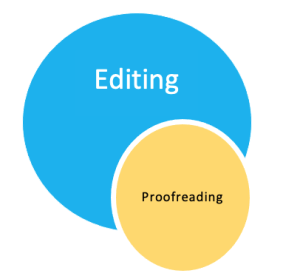31 Self-Edit Your Work
 Proofreading is a part of editing, but editing is much more than proofreading.
Proofreading is a part of editing, but editing is much more than proofreading.
Editing: a process of revising the content, organization, grammar, and presentation of a piece of writing.
Proofreading: Checking for accuracy in a piece of writing that is nearly complete. Includes Checking smaller details of grammar, spelling and punctuation.
Self Editing
After you’ve finished creating a first draft of your paper or assignment, you’ll want to begin the process of editing and revising.
- Self-editing is a key part of the writing process. It’s a skill that takes time to develop.
- Editing allows you to present your ideas in the clearest and most effective way possible. It involves making improvements to all of a paper or assignment. Editing includes reviewing your thesis, supporting details, paragraph structure, sentence structure and grammar, and the organization of your assignment.
Self-Editing in 5 Steps
It can be hard to know where to start when editing. Following these 5 steps can help take the mystery out of the editing process.
Step 1: Check the assignment instructions
- Compare the assignment instructions to your draft. Use the instructions like a checklist.
- Look for information or details missing from your assignment and focus on those areas.
- Compare your draft to the rubric provided by your instructor.
- Note any adjustments you need to make before submitting your assignment.
Step 2: Check the thesis
- Is it the right type of thesis for the kind of paper or assignment you’re writing?
- Can it be more specific? Is it clear? Does it tell the reader what you’re going to talk about in the paper/assignment?
- Does it match the conclusions you draw in the body of the paper/assignment?
- Does it explain the significance of your argument?
Step 3: Check the body paragraphs
- Is each topic sentence easy to identify?
- Is there evidence to support your ideas? Have you properly cited the sources of the evidence?
- Is it clear how the evidence supports the ideas?
- Have you explained/discussed the evidence thoroughly?
- Is there a smooth transition from one paragraph to the next?
Step 4: Check the introduction and conclusion
- Does the introduction introduce the topic and engage the reader?
- Does the conclusion do more than repeat what you already said?
- Does the conclusion elaborate on the significance of the thesis?
- Is the conclusion clear?
Step 5: Proofread the paper
- Do this several times.
- Make major revisions first. Do your ideas come across clearly?
- Then check for grammar mistakes, awkward sentences, repetition, citations, style, and formatting.
- Use built-in tools in Word to help. Using the Read Aloud function in Microsoft Word can help you hear how your assignment is read and catch grammatical errors.
Proofreading
Proofreading is an important step in the editing process. It involves looking at smaller details like spelling, grammar, punctuation, and word choice. Proofreading comes after you have edited the content and organization of your assignment. A good editing process moves from the “big picture”, step-by-step towards the smaller details.
Try it!
Take out the first draft of any piece of writing you’re currently completing.
- Follow the 5 steps listed above.
- How does following this process help you to edit your work in a systematic way?


Feedback/Errata